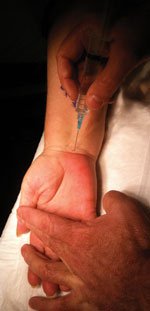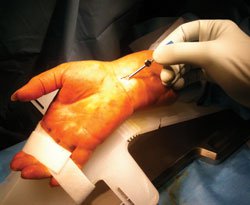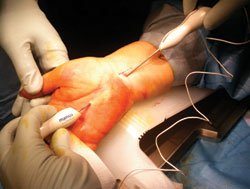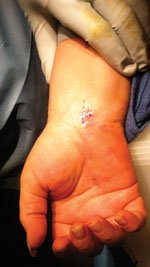Percutaneous carpal tunnel release using nerve conduction monitoring requires no incisions
The treatment of carpal tunnel syndrome has changed from previous extensile incisions under general anesthesia. Both open and endoscopic techniques have evolved to minimize incision length and recovery time and allow patients to return to work more quickly.
This article describes a new percutaneous technique for the treatment of carpal tunnel syndrome which utilizes nerve conduction monitoring and intraoperative patient feedback to safely perform the surgery without any incisions.
Planning, surgical setup
Preoperative evaluation of patients with carpal tunnel syndrome has been well-documented in the literature. A full history should be performed including evaluation of possible medical causes of carpal tunnel syndrome such as diabetes, thyroid disease and inflammatory disease. Physical examination should evaluate strength, atrophy, sensation, function and provocative tests. When patients do not respond adequately to bracing, activity modifications or medical treatments, nerve conduction testing may be performed.
Carpal tunnel release surgery is discussed with patients for whom nonoperative treatments were ineffective and who have objective evidence of carpal tunnel compression. Surgical results are best in patients with relatively severe nerve compression who do not yet exhibit severe muscle atrophy.
|
Images: Gunther SB |
Surgical technique
Patients are positioned supine using an arm table. The surgery is performed under local anesthesia which can be supplemented with mild intravenous sedation if necessary. It is important to anesthetize the proximal wrist crease, soft tissue superficial to the transverse carpal ligament, and soft tissue just distal to the transverse carpal ligament (Figure 1). Injection into the carpal tunnel should be avoided so that nerve monitoring can be performed during the procedure.
A special arm positioner (MANOS Incisionless Carpal Tunnel Release System, Thayer Intellectual Property, Inc.) is used to hold the wrist in a hyperextended position. No tourniquet is necessary for this surgical technique.
A sharp trocar is used to penetrate the skin along the most proximal wrist crease on the ulnar side of the palmaris longus tendon (Figure 2). The trocar is then placed gently through the transverse carpal fascia and into the proximal aspect of the carpal tunnel while aiming distally toward the ulnar aspect of the long finger. The trocar is then removed and the MANOS 14-gauge instrument is placed into the ulnar side of the carpal tunnel.
Nerve monitoring is then performed to ensure that the instrument has no contact with the median nerve or the motor branch of the median nerve.
|
|
|
The patient is then asked to move the fingers and thumb to ensure that the tendons are free and not tethered to the instrument. The cutting mechanism within the device is then advanced and exits through the palm just distal to the transverse carpal ligament while the wrist is hyperextended. The exit point is carefully chosen to avoid the superficial palmar arch.
A locking end cap is placed on the tip of the guide wire outside of the skin. The surgeon then pulls back and forth on the device multiple times in a gentle sliding motion while pressing on the palmar aspect of the hand (Figure 3) to release the transverse carpal ligament. The surgeon or assistant palpates the fascial release through the palmar skin. The instrument is then removed.
Closure, postoperative care
|
|
Sterile skin glue is placed over the entry and exit points (Figure 4). A sterile dressing is applied and the patient is encouraged to begin immediate active hand exercises. Hand elevation for 1 day is suggested to minimize swelling, but patients may use the operative hand for light activities immediately after surgery. Minor palm soreness may occur for a few days after surgery. However, patients are encouraged to resume normal activities, including return to light work within 1 week of surgery. Heavier lifting may be resumed 2 to 3 weeks after surgery or whenever tolerated by the patient.
Case example
A 72-year-old right-hand-dominant neurosurgeon was diagnosed with left carpal tunnel syndrome through clinical and neurologic testing. Nonoperative treatments failed to relieve his symptoms. Percutaneous carpal tunnel release was performed under local anesthesia and mild intravenous sedation with intraoperative nerve conduction monitoring. His symptoms were completely relieved. He returned to work the following day and performed surgery 1 day after his procedure.
This surgical technique for percutaneous carpal tunnel release is safe and effective. The surgery is performed under local anesthesia. Patients may return to their usual activities including work in an expedited fashion.
References:
- Piazzini DB, et al. Clin Rehabil. 2007;21(4):299-314.
- Shores JT, et al. Plast Reconstr Surg. 2010;126(6):2196-204.
- Stephen B. Gunther, MD, William W. Bowen, MD, and Yoshihiro Katsuura can be reached at Frank R. Howard Memorial Hospital, 84 Madrone St., Willits, Ca 95490; 707-459-6855; e-mail: sbgunther@aol.com.
- Disclosures: Gunther, Bowen and Katsuura have no relevant financial disclosures.
|
|
While this method is intriguing, I would urge caution and consider this experimental. In carpal tunnel surgery, the less one sees, the greater the likelihood of nerve damage — a potentially devastating complication — and the greater the risk of incomplete release. That’s why even advocates of endoscopic surgery bail out to open if they can’t see well.
The impetus for smaller incisions is presumably faster recovery, but it’s difficult to imagine faster recovery and return to work than we already see for deskworkers that have an open carpal tunnel release through a 2- to 3-cm incision under local anesthesia. It’s not clear that the added resources (costs, equipment, time) are justified.
To determine the safety of this technique we need to decide how many nerve injuries is too many. Is it one in 1,000? One in 10,000? Fewer? Prospective studies with adequate power must then be performed. To study comparative effectiveness, we need a prospective randomized study of deskworkers with electromyography-confirmed idiopathic median neuropathy at the carpal tunnel (preferably more than mild) that are allowed to return to work immediately after surgery without splints, while preventing marketing such as “minimally invasive” that might bias behavior.
— David C. Ring, MD, PhD
Director of
research, hand/upper extremity service
Associate professor of orthopedic
surgery
Harvard Medical School
Orthopedics Today editorial
board member
Disclosure: He has no relevant financial disclosures.











